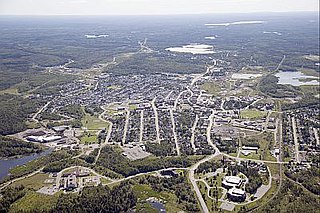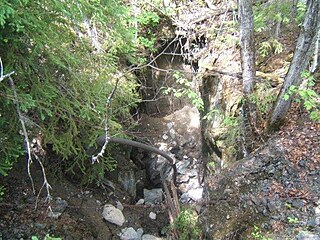
Timmins is a city in northeastern Ontario, Canada, located on the Mattagami River. The city is the fourth-largest city in the Northeastern Ontario region with a population of 41,145 at the 2021 Canadian census and an estimated population of 44,819 in 2023. The city's economy is based on natural resource extraction. It is supported by industries related to lumbering, and to the mining of gold, zinc, copper, nickel, and silver. Timmins serves as a regional service and distribution centre.

Kirkland Lake is a town and municipality in Timiskaming District of Northeastern Ontario. The 2016 population, according to Statistics Canada, was 7,981.

Cobalt is a town in Timiskaming District, Ontario, Canada. It had a population of 989 at the 2021 Census.
Gilbert A. LaBine, was a Canadian prospector who, in 1930, discovered radium and uranium deposits at Port Radium, Northwest Territories. LaBine was president of Eldorado Gold Mines from its start in the late 1920s to 1947. He left the company, which had become a Crown corporation in 1944, to prospect for uranium minerals as an independent mine developer. In the 1950s he brought the Gunnar Mine to production at Uranium City, Saskatchewan.

The Hollinger Gold Mine was discovered on October 9, 1909, by Benny Hollinger, who found the gold-bearing quartz dike that later became known as Hollinger Mines. With his friend, professional prospector Alex Gillies, Hollinger had travelled to the Porcupine region in the wake of the Wilson expedition, which had recently discovered the future Dome Mine site. Hollinger and Gillies staked three claims each, and one for their former partner, Bernard "Barney" P. McEnaney, who had been unable to join them due to severe sciatica.
The Canadian Mining Hall of Fame was conceived by Maurice R. Brown as a way to honor Canada's mine finders and builders, in recognition of accomplishments by leaders in the Canadian mining industry.
Noah Anthony Timmins was a Canadian mining financier and developer who is now counted among the founding fathers of Canada's mining industry.

Devil's Rock is a granite escarpment located 5 kilometres (3 mi) south of Temiskaming Shores, Ontario, Canada. The cliffs rise 300 feet (91 m) above Lake Timiskaming and extend nearly as far underwater as they do above, giving Devil's Rock a cliff face roughly 600 feet (180 m) tall.

The Porcupine Gold Rush was a gold rush that took place in Northern Ontario starting in 1909 and developing fully by 1911. A combination of the hard rock of the Canadian Shield and the rapid capitalization of mining meant that smaller companies and single-man operations could not effectively mine the area, as opposed to earlier rushes where the gold could be extracted through placer mining techniques. Although a number of prospectors made their fortune, operations in the area are marked largely by the development of larger mining companies, and most people involved in the mining operations were their employees.

The Hon. Michael John O'Brien was a railway builder, industrialist and philanthropist. He was named to the Senate of Canada in 1918. He was a founder of the town of Renfrew, Ontario. He was instrumental in the early history of professional ice hockey in Eastern Canada.
The Cobalt silver rush was a silver rush in Ontario, Canada that began in 1903 when huge veins of silver were discovered by workers on the Temiskaming and Northern Ontario Railway (T&NO) near the Mile 103 post. By 1905 a full-scale silver rush was underway, and the town of Cobalt, Ontario sprang up to serve as its hub. By 1908 Cobalt produced 9% of the world's silver, and in 1911 produced 31,507,791 ounces of silver. However, the good ore ran out fairly rapidly, and most of the mines were closed by the 1930s. There were several small revivals over the years, notably in World War II and again in the 1950s, but both petered out and today there is no active mining in the area. In total, the Cobalt area mines produced 460 million ounces of silver.
Silver Centre is a ghost town in Timiskaming District, Northeastern Ontario, Canada, situated in South Lorrain Township. It is located approximately 35 km (22 mi) south of North Cobalt, and 3 km (1.9 mi) west of Highway 567. Silver Centre was a secondary camp to the great silver fields of Cobalt, discovered in 1903. There are no current residents in Silver Centre. It is still an active mineral field and does at times have active mineral exploration.

Beanland Mine, also known as Clenor Mine, is an abandoned surface and underground mine in Northeastern Ontario, Canada. It is located about 1 km (0.62 mi) west of Arsenic Lake and 4 km (2.5 mi) northwest of the town of Temagami in central Strathy Township. It is named after Sydney Beanland, who first claimed the mine site in the 1920s and was a director for the mine from 1937 to 1938.
The Coniagas Mine is an abandoned silver mine in Cobalt, Ontario, Canada, located on the western side of Cobalt Lake. The mine was discovered in May 1903 by William Griffith Trethewey. The claim was sold to R. W. Leonard of St. Catharines Ontario and placed into production in 1904. The mine and the associated Coniagas Reduction Works of St Catharines operated until 1924 when known reserves were exhausted. The Coniagas Group was noted in mining circles being involved in the establishment of the Coniaurum Mine in Timmins and the Sturgeon River Mine in Geraldton Ontario.
John McMartin was a businessman, mining executive and political figure in Ontario, Canada. He represented Glengarry and Stormont in the House of Commons of Canada from 1917 until his death in 1918, as a Unionist Party member.

Keeley-Frontier Mine is a large abandoned mine in the ghost town of Silver Centre, Northeastern Ontario, Canada. It consists of two underground mines that were sunk 1,455 ft (443 m) below the surface. Keeley Mine was discovered in 1907 while Frontier Mine was constructed in 1921. The 8th level of the Keeley Mine connected with the 6th level of the Frontier Mine in 1962, creating the two compartment Keeley-Frontier Mine. In 1965, Keeley-Frontier Mine closed with a total production of 19,000,000 oz (540,000,000 g) of silver, 3,300,000 lb (1,500,000 kg) of cobalt, 27,000 lb (12,000 kg) of nickel and 10,000 lb (4,500 kg) of copper.
Benjamin Hollinger (1885–1919) was a Canadian barber turned prospector from Haileybury, Ontario, now considered one of the Founding Fathers of Timmins, Ontario, Canada. He was born April 10, 1885, in Point Alexander, Ontario, the youngest son of schoolteacher John Hollinger and Sarah Sutherland.
Henry Timmins was a Canadian shopkeeper who, with his younger brother, Noah, became an influential mining financier. The brothers are considered to be among the most significant founding fathers of the Canadian mining industry.

David Alexander Dunlap was a Canadian lawyer, mining company executive and philanthropist. He and his partners acquired an Ontario silver mine called LaRose, which was the basis of the great fortune he came to amass.

The Kerr–Addison Mine is an abandoned Canadian gold mine in the Kearns area of McGarry, Ontario. In 1960, the mine was the largest producer of gold in North America. The mine produced the second most gold overall in North America, with the Homestake Mine being the leader.